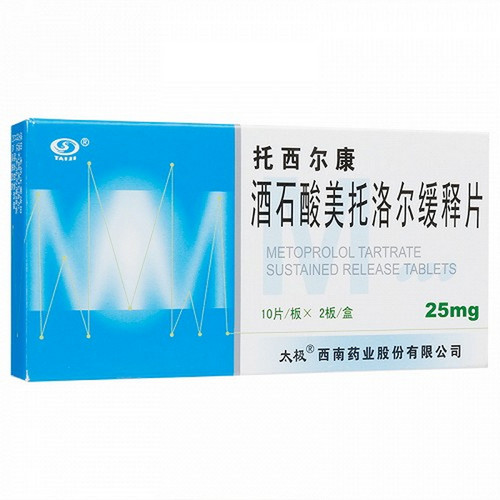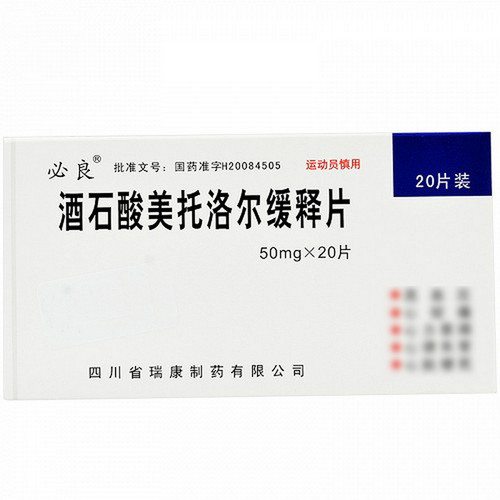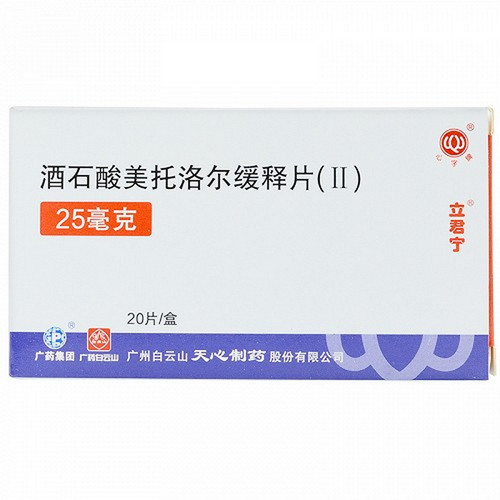Product Overview
[Drug Name]
Generic Name: Metoprolol Tartrate Sustained-Release Tablets
Trade Name: TuoXierkang Metoprolol Tartrate Sustained-Release Tablets 50mg x 20 Tablets
Pinyin Code: TuoXiErKang JiuShiSuanMeiuoLuoErHuanShiPian 50mg x 20 Tablets
[Main Ingredient]
Metoprolol Tartrate.
[Properties]
This product is a film-coated tablet that appears white or off-white after removal of the coating.
[Indications/Main Functions]
It is used to treat hypertension, angina pectoris, myocardial infarction, hypertrophic cardiomyopathy, aortic dissection, arrhythmias, hyperthyroidism, and cardiac neurosis. In recent years, it has also been used to treat heart failure. It should be used under the guidance of an experienced physician.
Specifications]
25mg x 20 tablets
[Dosage and Administration]
For the treatment of hypertension, 100-200mg twice daily is equivalent to 100mg atenolol once daily. . Acute myocardial infarction: It is recommended to use it in the early stage, that is, in the first few hours, because immediate use can reduce the infarction area and reduce the short-term (15-day) mortality rate in patients who have failed to undergo thrombolysis (this effect appears 24 hours after taking the drug). It can reduce the reinfarction rate and re-ischemia rate in patients who have already undergone thrombolysis, and it can also reduce the mortality rate if the drug is used within 2 hours. General usage: Metoprolol can be injected intravenously at 2.5-5 mg/time (within 2 minutes), once every 5 minutes for a total of 3 times of 10-15 mg. Then take 25-50 mg orally starting 15 minutes later, once every 6-12 hours times, for a total of 24 to 48 hours, and then take 50 to 100 mg orally each time, twice a day. Unstable angina: Early use is also recommended, and the usage and dosage can refer to acute myocardial infarction. If there are no contraindications when atrial fibrillation occurs in acute myocardial infarction, metoprolol can be used intravenously, and the method is the same as above. If there are no contraindications after myocardial infarction, it should be used for a long time, because it has been shown that doing so can reduce cardiac mortality, including sudden death. Generally 50 to 100 mg/time, twice a day. In the treatment of hypertension, angina pectoris, arrhythmia, hypertrophic cardiomyopathy, hyperthyroidism, etc. Generally, the dosage is 25-50 mg/time, two to three times daily, or 100 mg/time, twice daily. Heart Failure: This drug should be used in addition to anti-heart failure treatment with digitalis and/or diuretics. Initially, the dosage is 6.25 mg/time, two to three times daily. Depending on the clinical condition, the dosage can be increased by 6.25-12.5 mg/time, two to three times daily, every few days to a week, up to a maximum of 50-100 mg/time, twice daily. The maximum dose should not exceed 300-400 mg/day.
[Adverse Reactions]
Store in a dry, airtight container, away from light.
[Precautions Contraindications]
Significant bradycardia (heart rate <45/minute), cardiogenic shock, severe or acute heart failure, poor peripheral perfusion, moderate or severe atrioventricular block, sick sinus syndrome, and severe peripheral vascular disease.
[Drug Interactions]
Combination with cimetidine or pre-administration of quinidine may increase metoprolol blood concentrations.
[Precautions]
Propranolol can delay the recovery of blood glucose levels after insulin administration, but this adverse effect is less pronounced with selective β1-blockers. It is important to note that when β-blockers are added to diabetic patients taking insulin, their β-blocking effects can often mask symptoms of hypoglycemia, such as palpitations, thereby delaying the timely detection of hypoglycemia. However, during treatment, selective β1-blockers may be effective. Beta-blockers are less likely to interfere with glucose metabolism or mask hypoglycemia than non-selective beta-blockers. If you want to discontinue treatment during long-term use of this product, you must gradually reduce the dose and generally withdraw it within 7 to 10 days, and at least 3 days must pass. In particular, sudden discontinuation of the drug in patients with coronary heart disease may worsen the condition, leading to angina pectoris, myocardial infarction, or ventricular tachycardia. There is no consensus on whether to stop using beta-blockers before major surgery. After beta-blockade, the heart's response to reflex sympathetic excitation is reduced, increasing the risk of general anesthesia and surgery, but this can be reversed with dobutamine or isoproterenol. Despite this, it is best to stop using this drug for patients who are undergoing general anesthesia, and if possible, it should be stopped 48 hours before anesthesia. When used for pheochromocytoma, it should be exercised first. Use alpha-blockers. Use with caution in patients with hypotension, heart, or liver dysfunction. Metoprolol should also be used with caution in patients with chronic obstructive pulmonary disease and bronchial asthma. A low dose is recommended, generally less than that of atenolol of equal potency. Patients with bronchial asthma should also be treated with a beta-2 agonist, with the dose adjusted according to the metoprolol dose. Patients with cardiac decompensation should use metoprolol in addition to digitalis and/or diuretic therapy. For specific instructions, see
[Usage and Dosage]. It should not be used concomitantly with verapamil to avoid bradycardia, hypotension, and cardiac arrest. Careful observation is required when treating patients with type 1 diabetes mellitus (IDDM).
[Pharmacology and Toxicology]
This drug is a Class 2A drug, meaning it is not a partial agonist. An active β1-receptor blocker (cardioselective β-receptor blocker). It selectively blocks β1-receptors, lacks PAA (partial agonist activity), and has no membrane-stabilizing effects. Its β1-receptor blocking effect is approximately equal to that of propranolol (PP), but its selectivity for β1-receptors is slightly less than that of atenolol. Metoprolol's cardiac effects, such as slowing heart rate, inhibiting cardiac contractility, reducing automaticity, and delaying atrioventricular conduction time, are similar to those of propranolol and atenolol (AT). Its effect on reducing elevated blood pressure and heart rate during exercise testing is also similar to that of PP and AT. Its contractile effect on vascular and bronchial smooth muscle is weaker than that of PP, resulting in a smaller effect on the respiratory tract, but still more potent than that of AT. Metoprolol can also reduce plasma renin activity.








